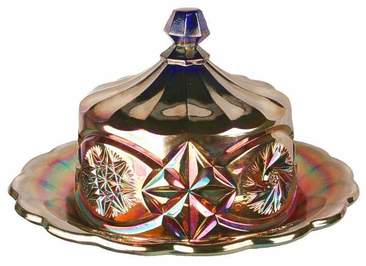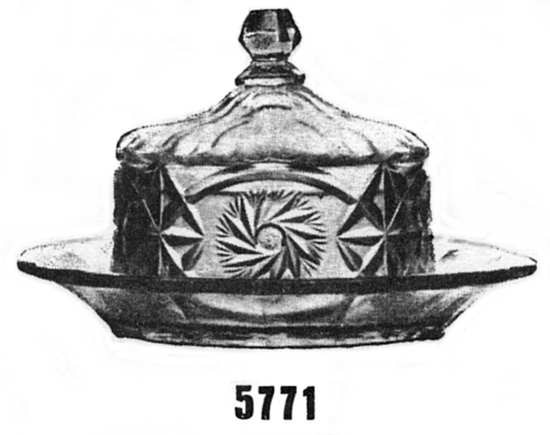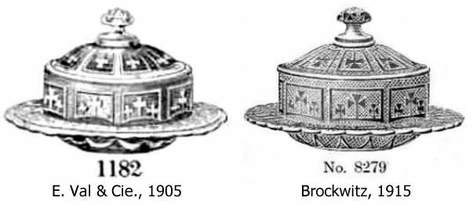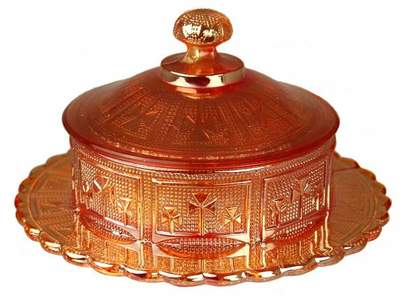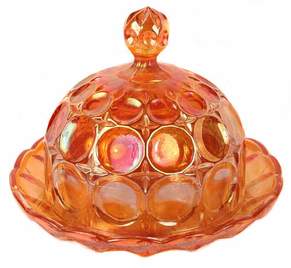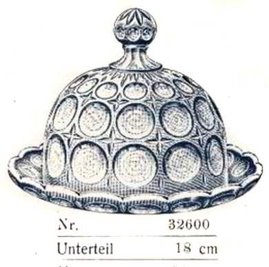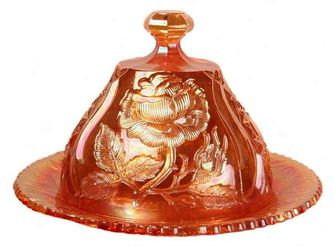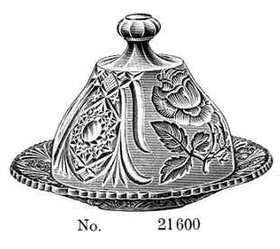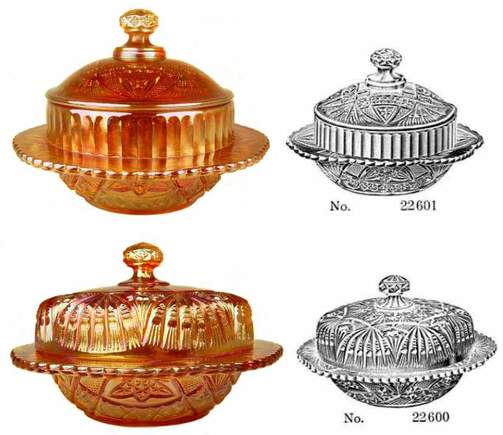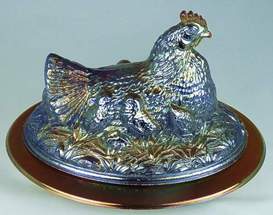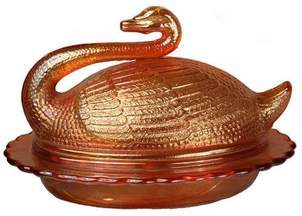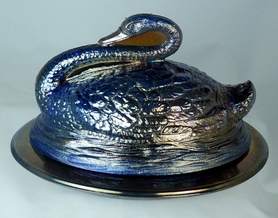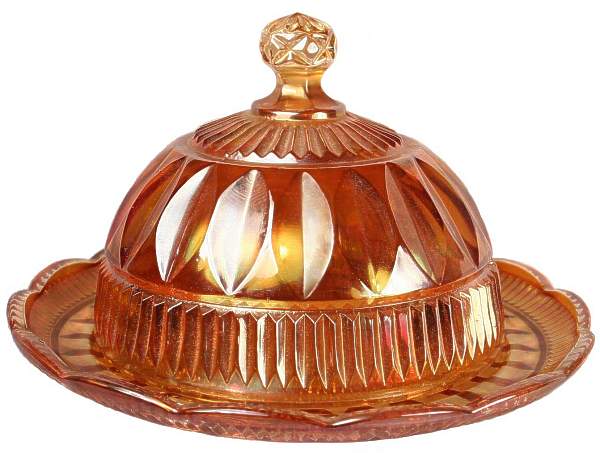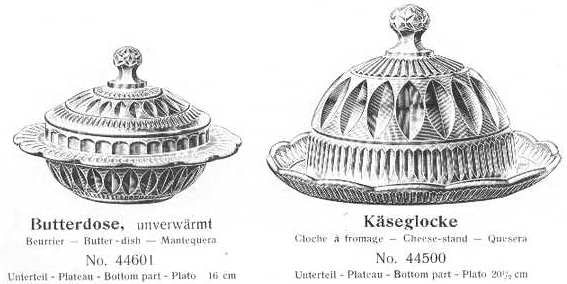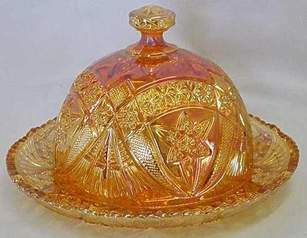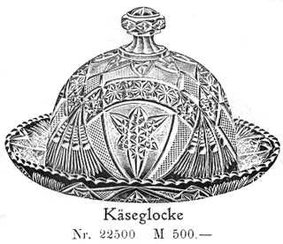Butter Me Up! Part Two
In "Butter Me Up! Part One" we looked into why most Classic Carnival butters were made in a round shape, and we started our journey by looking at covered butters made in the United States. Here, in part two, we continue our journey around the world.
Most Carnival Glass producers in europe made butter dishes, often as part of a larger table set. Note that European table sets were three-part sets, comprising a sugar, creamer and butter, unlike the four-part sets made in the USA which also included a spooner. To date, we are not aware of Eda Glasbruk or Inwald having made Carnival Glass butter dishes (but if you know of any, please send a photo!).
|
Finland - Riihimaki Starburst Riihimäki didn’t make many Carnival butter dishes, but they certainly got it right when they did them. This splendid blue example was found in Argentina, which has been the location of a number of splendid European Carnival “finds” owing to the fact that rather a lot was originally exported there. The base is 19cm (7.5”) wide. |
Germany - Brockwitz
Stippled Clover and Gothic: The Brockwitz butter below was found in Argentina by our friends Jorge Perri and the late Jorge Duhalde who gave it the name Stippled Clover and Gothic.
Stippled Clover and Gothic: The Brockwitz butter below was found in Argentina by our friends Jorge Perri and the late Jorge Duhalde who gave it the name Stippled Clover and Gothic.
|
The item is illustrated in Brockwitz’ 1915 catalogue where it has the number 8279. But wait! A retail catalogue from E. Val & Cie (formerly Maison Effler) in Paris, dated 1905, shows the same butter dish, with the number 1182. Val & Cie sold glass and china made by various manufacturers, and clearly Brockwitz was one of their early suppliers, as there are several other items in the 1905 catalogue that appear to be from Brockwitz.
|
Clearly this is an Brockwitz pattern and must have been launched very soon after they opened in 1903/4. But when was it made in Carnival Glass?
It could have been any time between 1904 and 1915. We have evidence that Brockwitz was making Carnival in 1915, but of course, they could have been doing it some time earlier. One further snippet is worth noting. In the E. Val & Cie 1905 catalogue there are some items (bobeches, a little “tub” and a double salt) listed as “iris". Carnival Glass, perhaps? They were pressed glass with a pattern: could this be evidence of European Carnival production as early as 1905?
It could have been any time between 1904 and 1915. We have evidence that Brockwitz was making Carnival in 1915, but of course, they could have been doing it some time earlier. One further snippet is worth noting. In the E. Val & Cie 1905 catalogue there are some items (bobeches, a little “tub” and a double salt) listed as “iris". Carnival Glass, perhaps? They were pressed glass with a pattern: could this be evidence of European Carnival production as early as 1905?
|
Rose Garden A seldom seen shape in this lovely pattern from Brockwitz. It is 18cm (7” wide) but it comes with a puzzle. There is a butter dish, but there are no matching sugar and creamer shapes! A marmalade dish with lid was illustrated in the catalogues, but no other table-set shapes. |
|
Curved Star - two shapes
Both are part of Brockwitz’ Curved Star (aka Zurich) range, and they were both sold and described as butter dishes. The Curved Star range was a very popular line, in fact it was probably Brockwitz's longest serving pattern, being produced in a wide range of shapes. Butter No. 22601 is more often seen. It has a ribbed, deep flange atop the base on which the lids sits. The pattern (despite the appearance in the catalogue illustration) is inside the lid. Perhaps it was done that way so the top could be wiped clean easily. The No. 22600 butter is more unusual and very hard to find. The flange on the base is smaller and not ribbed, the lid is a different shape (with steep shoulders) and the pattern on the lid is on the outside. It’s a very handsome piece of glass. One pattern—two variations. Note that both butters are 16 cm (6.25”) wide, measured across the widest part of the base. The difference between the base of the two butters can be seen clearly in the photo above. On the left is the scarce No. 22600 butter and on the right is the more easily found No. 22601 butter.
|
England - Sowerby
Whilst Sowerby made some "conventional" round butters, such as their Pineapple pattern, they also provided the consumer with some variety, most notably their well-recognised Covered Swan and Covered Hen butters.
Covered Hen and Covered Swan
The Covered Hen is found in marigold and blue. The Covered Swan was made from a revived mould that was originally used in the 1880s. Carnival versions are known in marigold and (rare) amethyst. It is a magnificent pressed glass butter and is arguably seen at its best in Carnival Glass. There is also a later version of the Covered Swan where the neck spaces were filled in - until recently (2018) it had only been reported in blue, but one in marigold has now been found.
South America
In collaboration with and with grateful thanks to Cláudio Deveikis and Álvaro Henrique Nicolau Aguiar for their ongoing research into Carnival Glass from Brazil, we were able to publish some wonderful examples of covered butters that were made and/or found in South America.
We published a major two part feature here on our website: Butters from Brazil.
In collaboration with and with grateful thanks to Cláudio Deveikis and Álvaro Henrique Nicolau Aguiar for their ongoing research into Carnival Glass from Brazil, we were able to publish some wonderful examples of covered butters that were made and/or found in South America.
We published a major two part feature here on our website: Butters from Brazil.
When is a "butter" not a butter - when it's a Käseglocke (cheese dish)!
Triands, Brockwitz
It looks like a butter, doesn’t it? But it isn’t! The high domed top fits onto an under-plate in much the same way as the Moonprint butter we showed above. But in fact it is a Triands cheese dish (aka cheese stand, or Käseglocke).
|
Curved Star, Brockwitz
As we said earlier, this pattern was made in a wide variety of shapes, so perhaps it is not surprising to find there was a cheese dish, and here it is. The top on this splendid cheese dish has a high dome and sits on a 21.5cm (8.5”) wide under-plate. |
Curved Star cheese dish, Brockwitz.
Courtesy of Seeck Auctions |
